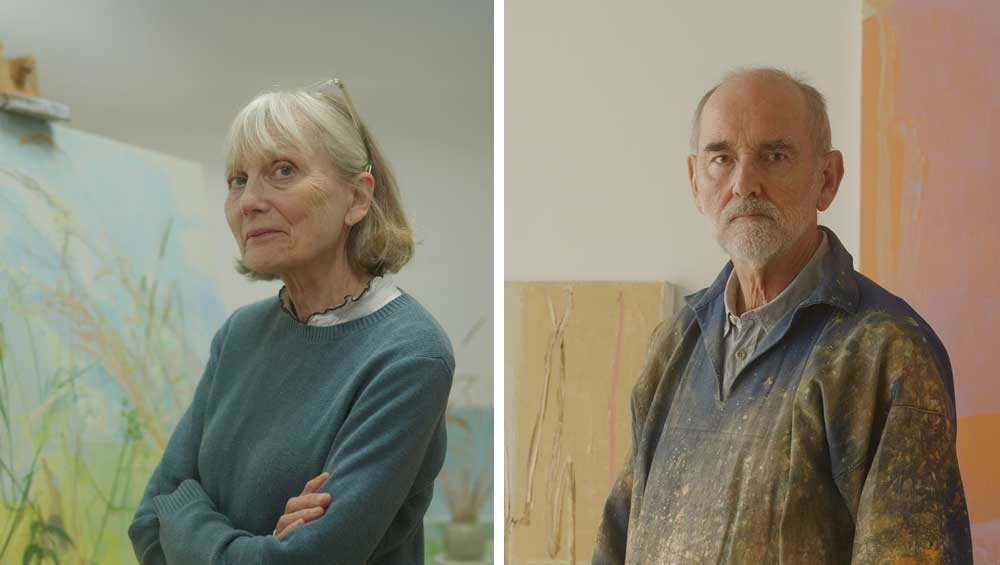
Charlotte Verity and Christopher Le Brun, 2024. Photos: Simon Dawson.
by ANGERIA RIGAMONTI di CUTÒ
Given the longevity of their union – they met in 1974 at the Slade School of Fine Art and married in 1979 – one might be tempted to refer to Christopher Le Brun (b1951, Portsmouth) and Charlotte Verity (b1954, Germany) in terms of their coupledom, but this would feel off-key. In the visual tête-à-tête on display in this oneiric exhibition, far from presenting a facile comparison – their works are not even displayed side-by-side – each hand retains its own charged presence, like actors exchanging well-written lines.
It is also sometimes said that Le Brun works largely from the imagination while Verity meticulously registers what she observes, though this seems like a spurious dichotomy. The crystalline, tautly structured exactness of her botanic images, accumulations of moments, conveys an abstracted, stylised rendition of what is seen, while Le Brun’s more textural, quivering colour fields have long shifted between abstraction and figuration. Perhaps the prime communality between the two is a perpetual testing of what paint can continue to achieve as no other medium can.
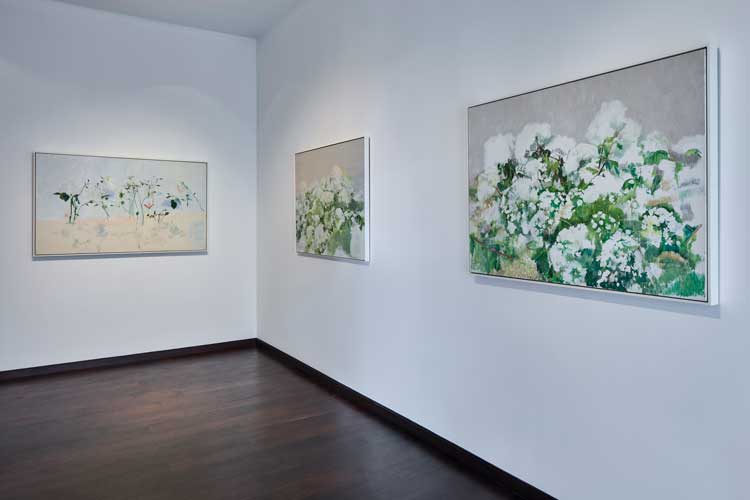
Christopher Le Brun and Charlotte Verity: Left Hand, Right Hand, installation view, The Gallery at Windsor, Florida, 2025. Photo: attascreative.
Le Brun and Verity responded in writing to Studio International questions about their singularly autonomous dialogue.
Angeria Rigamonti di Cutò: Although this exhibition is ostensibly a joint one, the works are displayed in separate rooms. Would a side-by-side hang have been too direct or have perturbed your respective oeuvres’ internal equilibrium in the context of a formal exhibition?
Charlotte Verity: These works were not painted with a direct dialogue in mind, it’s true. When I work, I concentrate on making the painting strong and self-sufficient and I’m sure it is the same for Christopher. But when the two groups of paintings were hung in close proximity, there was a sense of a relaxed conversation – a good conversation – between them, in the same way that poems follow each other in one volume, an anthology perhaps. To set up a direct comparison between individual paintings would have led to an artificial reading of each work and would have been visually confusing. The emphasis would be on the motif and would risk diverting the viewer’s attention from the infinitely subtle connections between the paintings from the same hand towards the superficial. Taking the four seasons as an example, Christopher has made a group of four canvases which, when together, form a sense of a whole year with its contrasts of mood and tempo. At the same time, the seasons and the changes occurring in the natural world have long formed an underlying structure to my work. I relish the shifts in detail of the visible world trusting that the images will lead to reflection on the wider world and our place in it. In both cases the narrative of the cycle of the year is just one of many elements of the work.
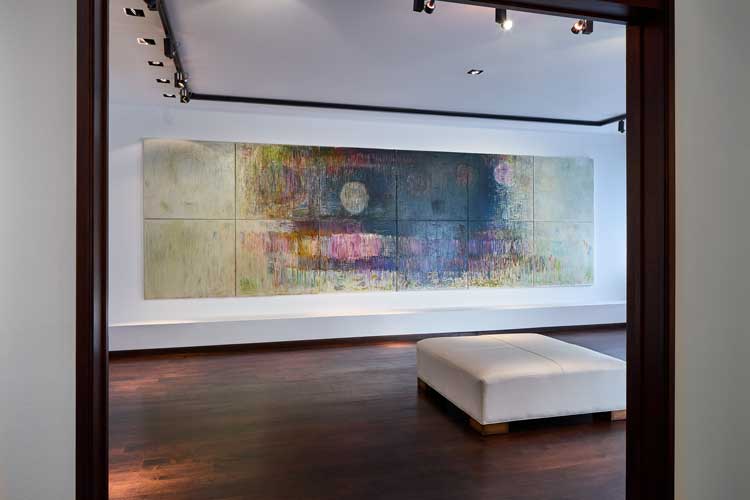
Christopher Le Brun and Charlotte Verity: Left Hand, Right Hand, installation view, The Gallery at Windsor, Florida, 2025. Photo: attascreative.
Christopher Le Brun: We felt that each group of paintings would benefit by being shown alongside related work. In that way, some sort of atmosphere can come about. There is such a thing as too much dialogue.
ARC: At home, do you hang your work together?
CLB: Yes, but not side by side.
CV: We do. I love living with Christopher’s work. And once a painting is finished and enough time has passed for me not to feel the anxieties around its making, it is a pleasure to hang it in our home and to live with it for a while.
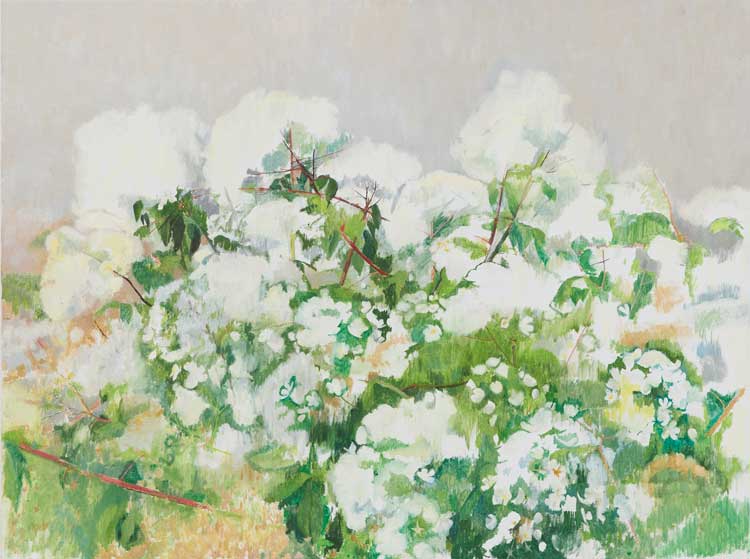
Charlotte Verity, From Above, 2020. Oil on canvas, 90.5 x 120.5 cm (35 5⁄8 x 47 1⁄2 x 1 1⁄8 in). © Charlotte Verity, all rights reserved DACS 2024. Courtesy albertz benda, New York.
ARC: Even with the structural separation of the hang, the exhibition inevitably invites an appraisal of commonalities and differences. Do you have a clear sense of what these are?
I find both of your work evades easy categorisation though it seems safe to say you're both attuned to natural forms and light. Charlotte, you reject being categorised as a botanical artist, your paintings seem more like still lifes, with the quasi-conceptual element of that genre, for all their empirical precision.
Christopher, your work, too, is hard to pin down: it's often been observed that you shifted from figuration to abstraction, though this distinction seems less important than the process of covering things up in your work, in a very tangible sense, with you frequently going over earlier passages on your canvas with new colour fields.
CV: I agree – I have always had trouble describing what I do because I don’t think of myself as a still life painter, or any other of the traditional (and I admit, useful) categories. Some of these paintings are not painted indoors, they do not involve tables or back walls or any set-up whatsoever. They take the world as I find it. Billow, From Above, Rose and Fell, My Nest and the smaller paintings, are all examples of this. Even when the setup is in the studio, it would appear to a visitor random and disordered and close to how it exists in nature.
Having lived together for so long, it is hard for me to analyse what our work has in common, but in general terms, I think it’s true to say that we both have confidence in the breadth and scope that painting offers and are open to, and excited by its possibilities. There is a lot more to do. I think that why this particular exhibition works well visually is that, without being self-conscious about it – it comes naturally – we take trouble to modify colour so that is fully expressive without using a preponderance of primary colours.
CLB: When you first come to paint every day, it is not surprising that the question of how to paint, comes to have as much importance as what to paint. The insights I gained into the process felt new and suggested a way of balancing conflicting possibilities whether abstract or figurative, in particular the acceptance or denial of the image. In some ways, my work of the 1980s forms a bridge or transition between artists of a previous generation who were straightforwardly abstract, such as Bridget Riley, Gillian Ayres and John Hoyland and painters such as Peter Doig and Gary Hume who take up the complex interaction of reference and formality that is at the heart of my work.
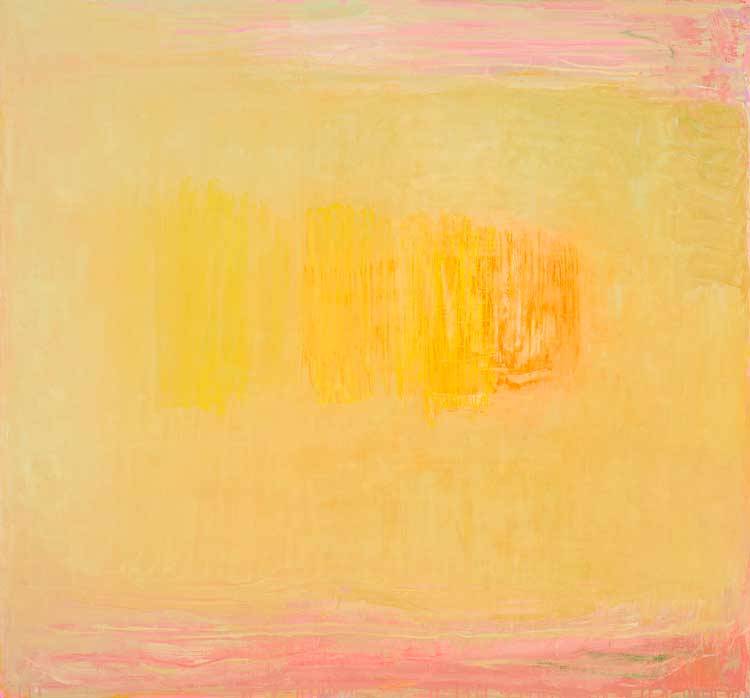
Christopher Le Brun, Phases of the Sun II, 2024. Oil on canvas, 130.5 x 140.5 cm (51 3⁄8 x 55 1⁄4 in). © Christopher Le Brun, all rights reserved DACS 2024. Courtesy albertz benda, New York.
ARC: Although almost every type of art is inevitably informed by the personal, in some cases this aspect is harder to discern for the spectator. Charlotte, you've said that you've tried to paint about motherhood in an “oblique” way, for example through the depiction of a rose’s strength and softness. To what extent do you think it's possible to transmit personal feelings and experiences into works whose subject is seemingly something else?
CV: It must be possible! If a work is made without feeling, it will be academic, which has its place of course, but not as the driver of art. I work with, not against my natural sensibilities, so the events that have shaped life must feed into the work – as I say, in an oblique way. It’s not always possible to identify feelings verbally or to pin them down, though being supremely articulate but expressive of the universal at the same time is the great pleasure of art, any art. Something to aim for.
CLB: I made a sculpture in 1997 entitled The Motif is Not the Subject. Painting can certainly convey feeling, but your question is about how metaphor and symbol work. That’s what enables Cézanne to convey so much whether the motif is an apple or a mountain. We are fortunate that words don’t apply, painting being a physical thing in a world of physical things. If anything, painting is opaque and resists meaning. This is a virtue in a world where we are drowning in messages. Looking doesn’t turn things into words, it’s doing something else.
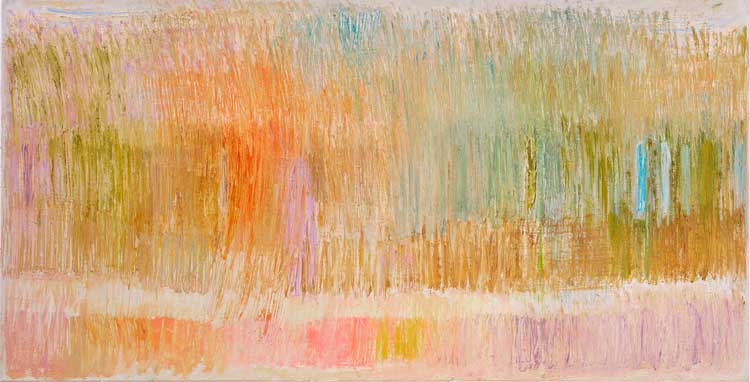
Christopher Le Brun, Small Seasons, Summer, 2023. Oil on canvas, 76.5 x 148.6 cm (30 1⁄8 x 58 1⁄2 in). © Christopher Le Brun, all rights reserved DACS 2024. Courtesy albertz benda, New York.
ARC: And Christopher, although you've described painting as being something of a self-contained process largely determined by its own art-for-art’s sake logic, as well as your imagination, do you also conceive of painting as a vehicle of self-expression in the terms Charlotte has described?
CLB: I think you are picking up on recent statements where I’ve deliberately overemphasised painting’s independence or art for art’s sake. I said this in the context of current intellectual fashions where there’s a tendency to make art somehow subservient, to recruit it on behalf of various causes or issues. I conceive of painting in the continuity of art history. Starting out in the 1970s, I wanted to reintroduce drawing and imagery into abstract painting that I felt had become formulaic. In the next decade that led to showing my work alongside Baselitz, Kiefer, Schnabel etc. The movement is sometimes called neo-expressionism or even postmodernism. Charlotte and I lived in Berlin in 1987 before the Berlin wall came down in 1989 so we met and befriended many of the artists.
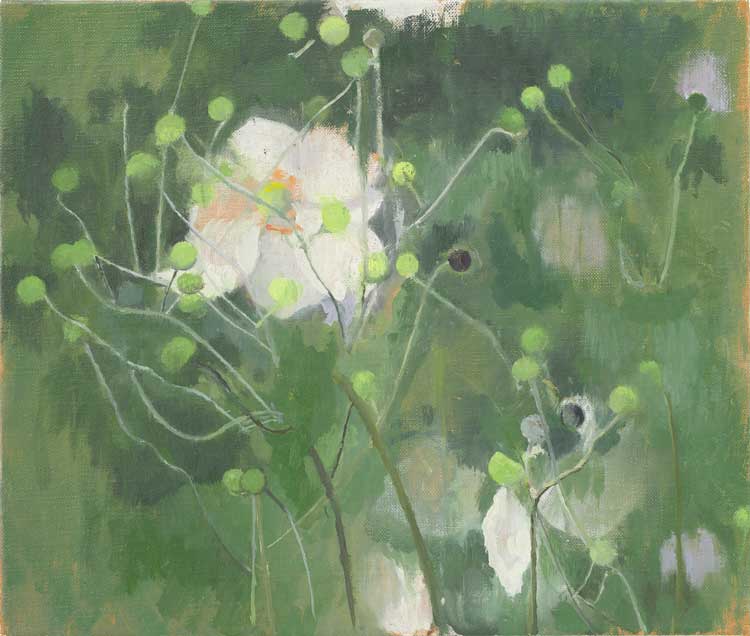
Charlotte Verity, Anemones, 2021. Oil on canvas, 25.3 x 30.7 cm (10 x 12 1⁄8 in). © Charlotte Verity, all rights reserved DACS 2024. Courtesy albertz benda, New York.
ARC: To what extent has moving to the countryside after decades in London affected your art? The reference to the natural world is significant in both, though particularly overt in your case Charlotte, so I would imagine, if that isn’t too obvious, the move having had more of an impact on your work than Christopher’s?
CV: As you imply, because I work directly from what I see – my daily surroundings and the familiar, it is inevitable that the paintings will take on a different look. To be specific for a moment, instead of a grey tarmac road as a backdrop to a rose stem, I have a green hill. The expanse of sky in London is interrupted by buildings, I treasured every patch; here the sky feels limitless and punctuated only by treetops. My Nest is about the boundary to our home in London. It is what enclosed our own space. I will not be moved to paint in the same way here, in the countryside, where I see (and feel) distance. The vermilion thorns in Rose and Fell, seemed like the brightest thing in the garden when I began the painting in London. Here, I have so much choice – that, perhaps, is the greatest difference.
CLB: I’ve walked and backpacked most of the long distance paths so I love the English countryside, its changing light suffuses my work. I was making prints in California once with its semi-permanent blue skies and the printmaker said: “We’ll get that grey English light out of you”. Not so easy … I’ve also had working studios in Somerset and Suffolk, so it’s not such a big leap.
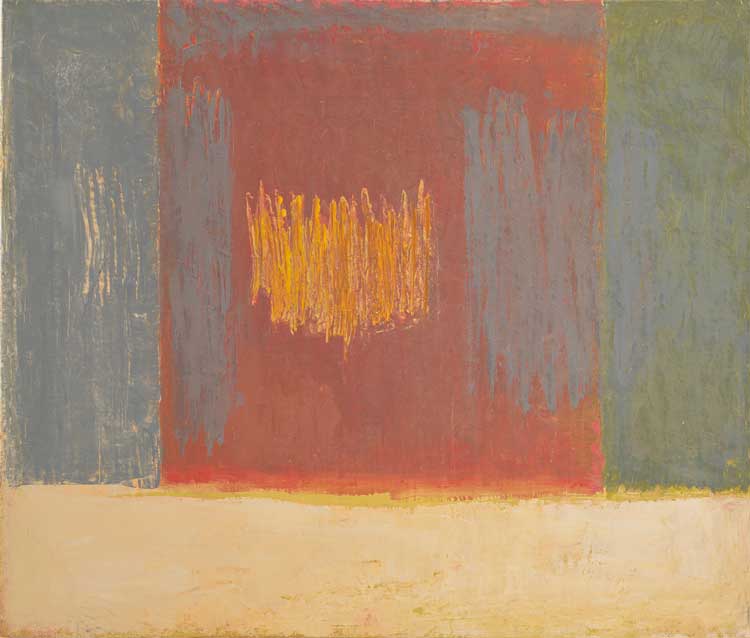
Christopher Le Brun, Cymbal, 2022. Oil on canvas, 85.3 x 100.3 cm (33 5⁄8 x 39 1⁄2 in). © Christopher Le Brun, all rights reserved DACS 2024. Courtesy albertz benda, New York.
ARC: You have both often spoken of the importance of poetry in your art. Can you touch on this relationship, for example to what extent it is specific and conscious.
CV: This is a big question, not easy to do justice here to all the poetry that has shaped my thinking. As well as being open to new work, there are many poets I return to – it is a long list! You questioned the ability for painting to transfer feelings and experiences into painting what I see around me, but this is what poetry can do and at its best, does do. It doesn’t exist to make lists and report. It also surprises the reader into seeing things afresh and innocently – a role that, as a painter, I am happy to take on.
Recently we visited Dove Cottage, in the Lake District. It is the tiny home that William Wordsworth shared with his sister, Dorothy. As is well known, she kept a notebook with her observations about their daily lives, and in beautiful, articulate prose, reported on seeing the daffodils being blown about by gusty wind coming over the lake: “They looked so gay ever glancing, ever changing.” Clearly, William’s very famous poem Daffodils is indebted to Dorothy’s attention to them and her report. But it is also true that, if he hadn’t formed a poem, the observation at its heart and which he connected to the metaphysical, would not have touched the lives of so many of us. The descriptions of what they both saw on that spring day, would have remained in her small notebook, probably unpublished. This is by way of answering your question, at least in part.
Poetry gives me courage to continue to try to do this very difficult thing. It is a reminder of what is important.
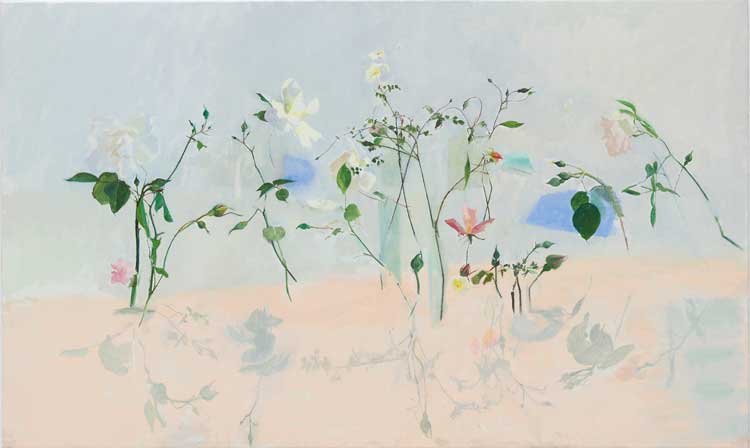
Charlotte Verity, Buds, 2020. Oil on canvas, 90.3 x 150.5 cm (35 1⁄2 x 59 1⁄4 x 1 1⁄4 in). © Charlotte Verity, all rights reserved DACS 2024. Courtesy albertz benda, New York.
CLB: I have always assumed that if you are interested in painting then you would be interested in poetry, so it never felt deliberate. It becomes specific at different times. In my teens it was the poets David Gascoyne and Edward Thomas, Blake, Keats and Wordsworth, and then, as the decades followed, it was Ezra Pound, Tennyson, Wallace Stevens and recently AR Ammons and Geoffrey Hill among many others. I gave a lecture on the relationship between poetry and painting at the Frick and an edited version appears in the book on my recent work to be published by Rizzoli this autumn.
ARC: Did the making of this joint exhibition ultimately enhance or shift your sense of a common ground, as well as differences?
CLB: There is a reassuring common ground, quite what that is I’m not sure, but it was pleasing to see two lives dedicated to the look of things finding a sort of harmony.
• Christopher Le Brun and Charlotte Verity: Left Hand, Right Hand is at The Gallery at Windsor, Florida, until 25 April 2025